[mashshare]

Resisted sled sprint (RSS) training is an effective method to improve linear sprint performance – but how do we load the sled?
This article will provide an overview of the current methods of sled load prescription for resisted sled sprint (RSS) training. We are at a very early stage of quantifying the potential of RSS training for improved sprint performance. However, before we can effectively apply RSS training with our athletes, we have to understand why and how we are loading the sled.
The Benefits of Resisted Sled Sprint (RSS) Training
Physical training improvements in sprint performance can occur via two general means:
- Increase in physical output
- e.g. increase production of triple extension force/power
- Improvement in efficiency of physical output
- e.g. increase in horizontal application of force
Sprint acceleration performance is largely determined by the angle of application of ground reaction force [1-3]. JB Morin and colleagues summarize the mechanical determinants of sprint acceleration as a ‘technical ability to apply horizontal force’ (Figure 1) [2]. RSS training is a tool to provide a potential improvement in horizontal application of force.

We constantly strive for effective and efficient methods for training transfer to performance. For an overview of ‘training transfer’, please read this top quality piece by Warren Young [4]. RSS training is likely to provide an enhancement of both physical output and efficiency of physical output .
Adding a resistive load provides an overload of the force component [5, 6]. RSS training acutely provides the athlete with less braking forces, [7-9] longer opportunity for greater forward trunk lean and, therefore, a better chance for horizontal application of force [7, 10-13]. Although athletes spend longer on the ground when sled sprinting, this provides more time to develop their ability to produce propulsive (or horizontal) forces [9, 10]
A recent review found 10 from 11 peer-reviewed studies observed RSS training improvements in either acceleration or maximal velocity sprint performance [14]. In sprint and strength-trained rugby players, 12 sessions of 3×20 m of RSS at a 12.6%BM sled load combined with 3×20 m of URS was enough to provide improvements in speed performance beyond 6×20 m of URS training alone [15]. The review also discounted the ‘heavy sleds make you slow’ myth. Sled loads from 12-43%BM were effective in the improvement of sprint performance.
Although RSS training is an effective method for improvements in sprint performance, the review deemed it unlikely to be more effective than unresisted sprint (URS) training [14]. However, many of the studies kept sled load rather light. Part 2 of this article will discuss RSS load and the potential adaptations from different loads. Secondly, RSS training may provide different neuromuscular and biomechanical adaptations to URS training alone.
Slow Down
But…we have a problem. We do not even have a grasp on the absolute fundamentals of resisted sprint training. We’re not even sure how to load the sled.
Our current situation reminds me of NASA’s Mars Polar Lander of which crashed as two separate teams were antagonistically working in imperial and metric units (I’m certainly not comparing sport science to rocket science – we’re obviously a lot smarter with our finances). Authors have utilized three different methods of sled load prescription used in peer-reviewed training studies. This is a problem. Without a uniform and agreed method of sled load prescription, we cannot begin to accurately discuss RSS volumes, intensities and training adaptations.
Absolutely Relative
Table 1 outlines the current and proposed methods of sled load prescription.
| Method | Characteristics | Limitations |
| Absolute load (kg) | Simple |
Does not account for body mass, sprint speed characteristics. Unlikely to provide targeted or uniform training stimulus across group of athletes. |
| Percentage of body mass (%BM) |
Simple, requires athlete weigh-in only. Accounts for athlete body mass. |
Does not account for force, power or sprint speed characteristics. Unlikely to provide targeted or uniform training stimulus across group of athletes. |
| %Vdec (decrement in unresisted sprint velocity) |
Accounts for differences in sprint performance. Likely to provide targeted or uniform training stimulus across group of athletes. Results from studies can be generalised to practice regardless of sled or surface type. Can be used with other measureable resisted sprint methods e.g. Run Rocket or Exer-Genie. |
Requires pre-testing with speed gates. No ‘maximal’ value means opportunity to periodise RSS loads is unlikely. |
| %MRSL (maximal resisted sled load) [16] |
Accounts for differences in sprint acceleration performance. Likely to provide targeted or uniform training stimulus across group of athletes. ‘Maximal’ value provides opportunity for periodisation of RSS loads Results from studies can be generalised to practice regardless of sled or surface type. Can be used with other measureable resisted sprint methods e.g. Run Rocket or Exer-Genie. |
Requires pre-testing with speed gates, of which can hold time-constraints with large groups. |
I do not prescribe an absolute load (e.g. 10kg) or a load relative to athlete body mass (%BM). I would not ask a squad of 15 rugby players to each back squat 100kg, or hang clean 50% of their bodyweight. Why generalize these methods to RSS training? Body mass is rarely a determinant of sprint performance. Furthermore, RSS performance is related to individual force, power and sprint characteristics [16]. RSS programs prescribed with either absolute or %BM methods mean the coach is providing a non-uniform or unknown training stimulus among athletes (Figure 2). Alternative approaches are required.

Alternative loading strategies must account for an athlete’s resisted sprint velocity or acceleration ability. Table 1 outlines the benefits and limitations of two alternative resisted sprint loading methods: %Vdec (decrement in unresisted sprint velocity) and %MRSL (maximal resisted sprint load).
Measurement of %Vdec is simple (Table 2) and application of this method has been used in various training studies [11, 17-21]. This method has much potential for use in applied settings. It accounts for both unresisted and resisted sprint velocity. Therefore, %Vdec accounts for the technical demands of resisted sprinting (e.g. greater trunk angle, changes in force production, changes in force application).
| Steps | |
| 1 | Decide upon RSS training distance (say, 20m). |
| 2 | Test and record time/velocity for 20m URS trials. |
| 3 | Test and record time/ velocity for 20m RSS trials with a range of resisted loads. |
| 4 | Decide upon the % decrement in time/ velocity you wish train at – prescribe corresponding sled load. |
MRSL was originally developed by Martinez-Valencia, Pedro Alcaraz and their research group [16]. MRSL is somewhat of a misnomer. MRSL does not indicate the heaviest load before an athlete can physically move the sled. In this respect, it is not analogous to a traditional one repetition maximum (1RM).
The MRSL method is illustrated in Table 3 and Figure 3. Simply, MRSL is the “maximal load at which the athlete remains in sprint acceleration from 10 to 20 m in a 0-20 m resisted sled sprint”. For lovers of diagrams, Figure 4 further illustrates the description of MRSL. As we increase sled load, the rate of acceleration between 10 and 20m decreases. Eventually, sled load increases to the point where the athlete is decelerating, i.e. we have trialed beyond the maximal load to maintain acceleration.
| Steps | |
| 1 | Test and record times for 20m RSS trials. Record 10-15m (section A) and 15-20 m (section B) velocity. See diagram below. |
| 2 | If velocity of section A < section B, the athlete is accelerating. Perform next trial with heavier load (e.g. 5%BM). |
| 3 | If velocity of section A > section B, the athlete is decelerating. The corresponding load has surpassed MRSL. |
| 4 | Decide upon the %MRSL you wish train at – prescribe corresponding sled load. |

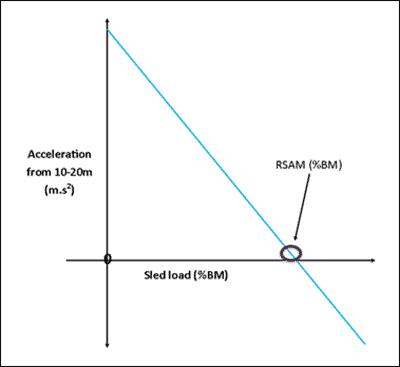
Although not identical, the idea of MRSL is not too far removed from the 1RM method of standard weight-lifting loading protocols. The MRSL test provides the practitioner with a single value. This value can act as a ‘maximal load’. Based on a ‘maximal load’, RSS loads can be programmed and based on the adaptation required by the practitioner. Part 2 of this article will expand on RSS programming using the MRSL method.
In-house research at UCD High Performance has shown MRSL to be a reliable method that significantly correlates with performance tests such as 0-10 m speed, 0-20 m speed, vertical and horizontal countermovement jump, horizontal bounding and loaded jump squats. Therefore, the test is certainly superior to the %BM or absolute load methods. MRSL loads were measured at between 22-50%BM for females and 30-65%BM for males. The top-end numbers are quite heavy, yes.
Figures 5-1 through 5-5 illustrate how heavier sleds induce greater forward trunk lean and, therefore, increase the likelihood of greater horizontal force application.
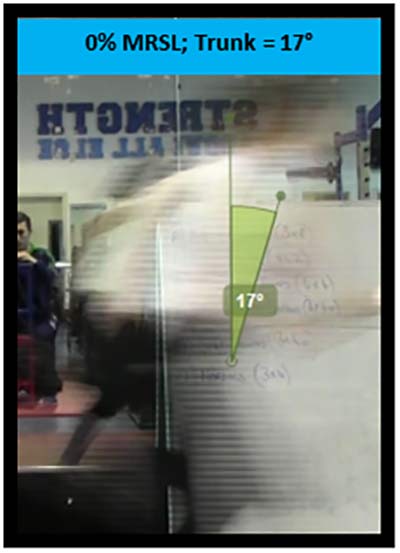
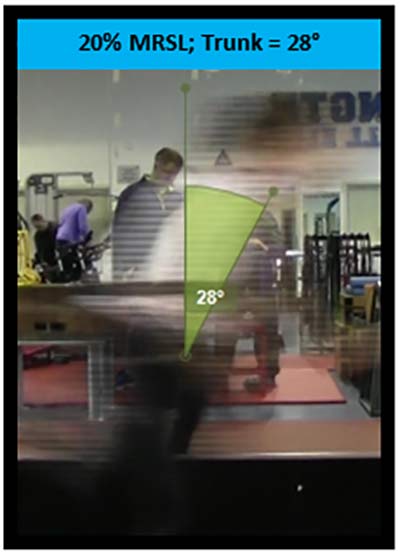
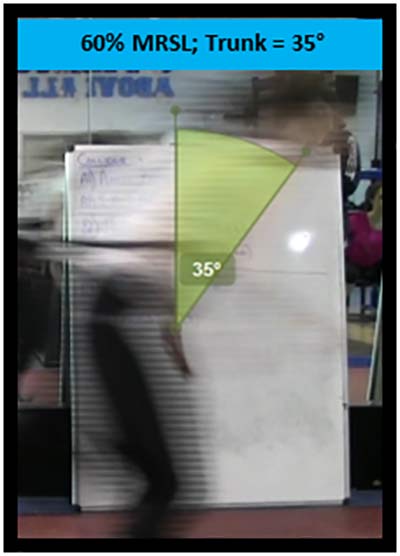
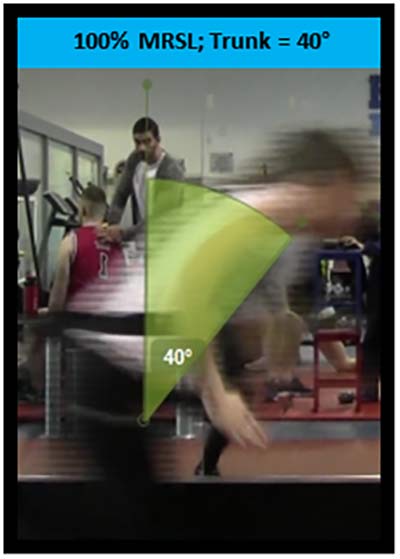
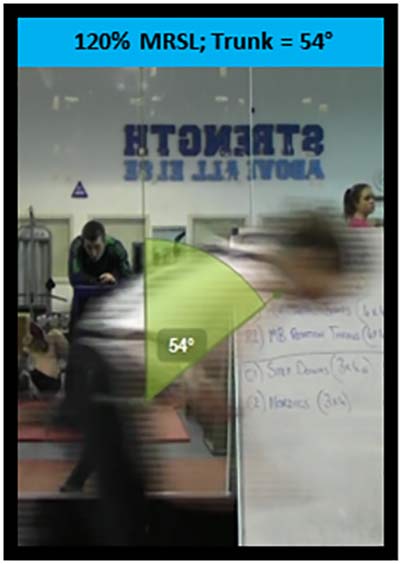
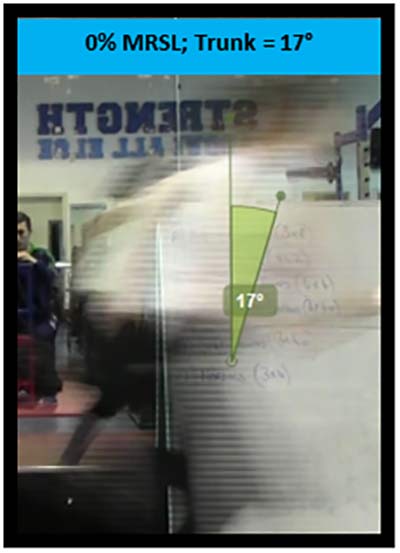
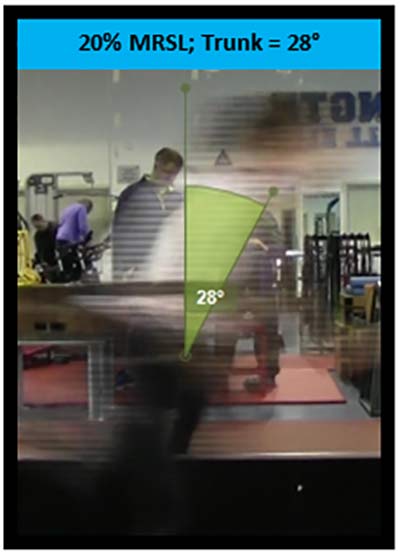
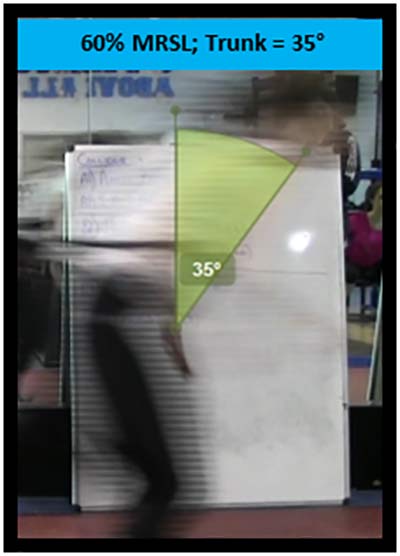
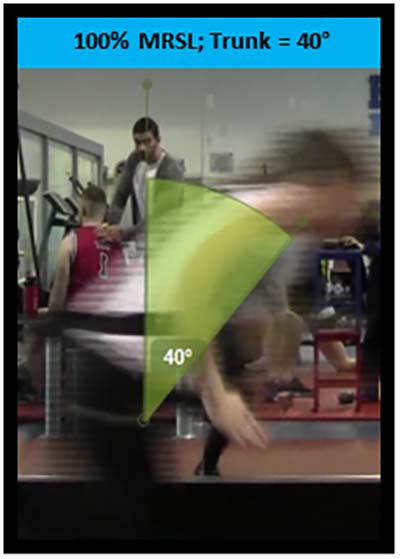
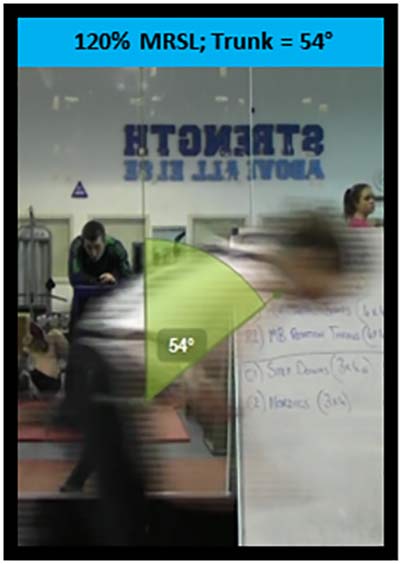
Provided the athlete is accelerating, the trunk lean during a resisted sprint will be specific to, or greater than, the trunk lean at a certain portion of URS acceleration, i.e. trunk lean over 20 m at 100%MRSL and that of very early URS acceleration. Therefore, training with loads close to MRSL may provide the athlete with increased exposure/ practice at the trunk angle experienced in early acceleration. More practice = a greater chance of developing a more favorable motor pattern or positive change in acceleration technique that enhances greater horizontal force application.
The practical application of MRSL will be discussed in Part 2 of this article.
Summary
- RSS training is an effect tool for improvements in sprint performance. Adaptations are likely related to improved horizontal application of force. However, we are yet unsure of how to prescribe sled load.
- Absolute or % BM sled load prescription methods do not account for sprint or acceleration performance. It is unlikely these methods provide a uniform stimulus between athletes.
- The %Vdec is a simple and relative method of resisted sled load prescription. This method accounts for between-athlete differences in sprint performance and resisted sled sprint mechanics. However, this method does not inform the coach of a ‘maximal’ load or a measure of acceleration quality.
- The MRSL method is superior in terms of providing an understanding of the relationship between sled load and the trunk angles obtained during specific URS phases.
Pinch of Salt
This piece of work is established from a combination of research evidence, opinion and most importantly, training/ coaching experience. I still have much to discover, and I invite critique, questions, and discussion. There will be many out there who have alternative opinions and experiences; please share.
All papers mentioned in this article can be found here.
Acknowledgements
I wish to thank Dr Brendan Egan, Dr Eamonn Flanagan and Stuart McMillan for their excellent comments in the revision of this article.
Since you’re here…
…we have a small favor to ask. More people are reading SimpliFaster than ever, and each week we bring you compelling content from coaches, sport scientists, and physiotherapists who are devoted to building better athletes. Please take a moment to share the articles on social media, engage the authors with questions and comments below, and link to articles when appropriate if you have a blog or participate on forums of related topics. — SF
[mashshare]
References
- Morin JB, Bourdin M, Edouard P et al. Mechanical determinants of 100-m sprint running performance. Eur J Appl Physiol. 2012;112(11):3921-30.
- Morin JB, Edouard P, Samozino P. Technical ability of force application as a determinant factor of sprint performance. Med Sci Sports Exerc. 2011;43(9):1680-8.
- Rabita G, Dorel S, Slawinski J et al. Sprint mechanics in world-class athletes: a new insight into the limits of human locomotion. Scand J Med Sci Sports. 2015.
- Young WB. Transfer of strength and power training to sports performance. Int J Sports Physiol Perform. 2006;1(2):74-83.
- Cottle CA, Carlson LA, Lawrence MA. Effects of sled towing on sprint starts. J Strength Cond Res. 2014;28(5):1241-5.
- Martínez-Valencia MA, Romero-Arenas S, Elvira JL et al. Effects of Sled Towing on Peak Force, the Rate of Force Development and Sprint Performance During the Acceleration Phase. J Hum Kinet. 2015;46(1):139-48.
- Cronin J, Hansen K, Kawamori N et al. Effects of weighted vests and sled towing on sprint kinematics. Sport Biomech. 2008;7(2):160-72.
- Lockie RG, Murphy AJ, Spinks CD. Effects of resisted sled towing on sprint kinematics in field-sport athletes. J Strength Cond Res. 2003;17(4):760-7.
- Nogueira M, Viriato N, Vaz M et al., editors. Dynamometric analysis of resisted sled on sprint run. ISBS-Conference Proceedings Archive; 2011.
- Kawamori N, Newton R, Nosaka K. Effects of weighted sled towing on ground reaction force during the acceleration phase of sprint running. J Sports Sci 2014;32(12):1139-45.
- Kawamori N, Newton RU, Hori N et al. Effects of weighted sled towing with heavy versus light load on sprint acceleration ability. J Strength Cond Res. 2014;28(10):2738-45.
- Alcaraz PE, Palao JM, Elvira JL et al. Effects of three types of resisted sprint training devices on the kinematics of sprinting at maximum velocity. J Strength Cond Res. 2008;22(3):890-7.
- Maulder PS, Bradshaw EJ, Keogh JW. Kinematic alterations due to different loading schemes in early acceleration sprint performance from starting blocks. J Strength Cond Res. 2008;22(6):1992-2002.
- Petrakos G, Morin JB, Egan B. Resisted sled sprint training to improve sprint performance: a systematic review. Sports Med. 2015.
- West DJ, Cunningham DJ, Bracken RM et al. Effects of resisted sprint training on acceleration in professional rugby union players. J Strength Cond Res. 2013;27(4):1014-8.
- Martinez-Valencia MA, Gonzalez-Rave JM, Santos-Garcia DJ et al. Interrelationships between different loads in resisted sprints, half-squat 1 RM and kinematic variables in trained athletes. Eur J Sport Sci. 2014;14 Suppl 1:S18-24.
- Alcaraz PE, Elvira JLL, Palao JM. Kinematic, strength, and stiffness adaptations after a short- term sled towing training in athletes. Scand J Med Sci Sports. 2014;24(2):279-90.
- Clark KP, Stearne DJ, Walts CT et al. The longitudinal effects of resisted sprint training using weighted sleds vs. weighted vests. J Strength Cond Res. 2010;24(12):3287-95.
- Lockie RG, Murphy AJ, Schultz AB et al. The effects of different speed training protocols on sprint acceleration kinematics and muscle strength and power in field sport athletes. J Strength Cond Res. 2012;26(6):1539-50.
- Makaruk B, Sozanski H, Makaruk H et al. The effects of resisted sprint training on speed performance in women. Hum Mov. 2013;14(2):116-22.
- Spinks CD, Murphy AJ, Spinks WL et al. The effects of resisted sprint training on acceleration performance and kinematics in soccer, rugby union, and Australian football players. J Strength Cond Res. 2007;21(1):77-85.




